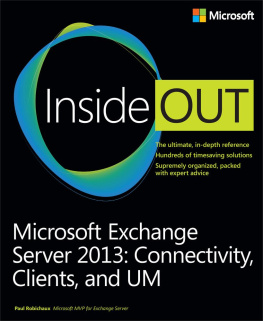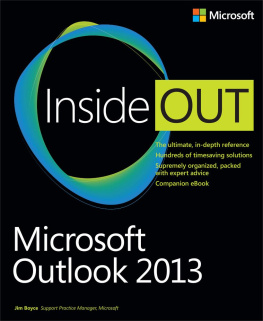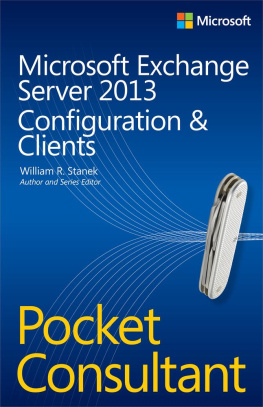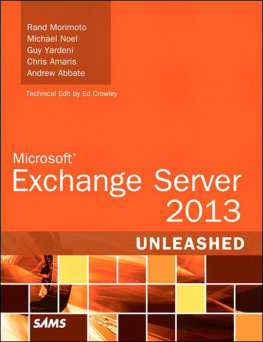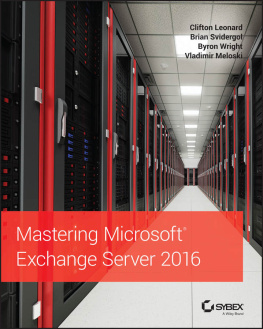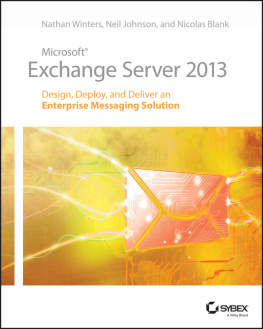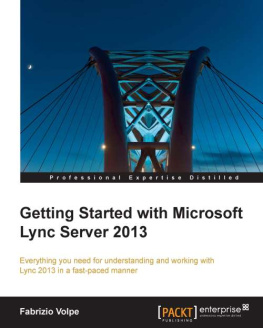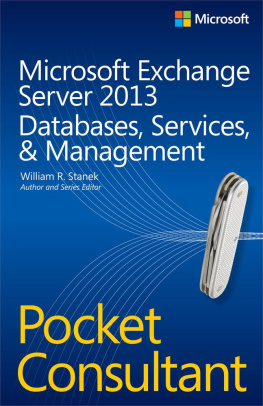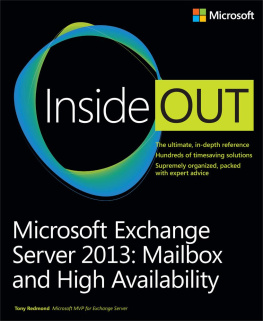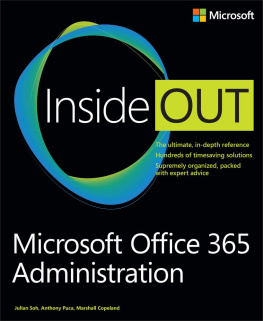Those seeking an in-depth tour of Exchange Server 2013 couldnt ask for better guides than Tony Redmond and Paul Robichaux. Tony and Paul have a relationship with the Exchange team that goes back two decades, to the days of Exchange 4.0. Few people have as much practical knowledge about Exchange, and even fewer have the teaching skills to match. You are in good hands.
Over the past few years, we have seen significant changes in the way people communicate; a growing number of devices, an explosion of information, increasingly complex compliance requirements, and a multigenerational workforce. This world of communication challenges has been accompanied by a shift toward cloud services. As we designed Exchange 2013, the Exchange team worked hard to build a product and service that address these challenges. As you read these books, youll get an up-close look at the outcome of our efforts.
From our new building-block architecture to data loss prevention, theres a lot to explore in the newest version of Exchange. I hope that as you deploy and use Exchange 2013, youll agree that this is an exciting and innovative release.
Introduction
This book is for experienced Exchange administrators who want to gain a thorough understanding of how client access, transport, unified messaging, and Office 365 integration work in Exchange Server 2013, the latest version of the Microsoft enterprise messaging server first released in October 2012 and updated on a frequent basis since. It isnt intended to be a reference, and it isnt suitable for novices.
In 2011, when Tony Redmond and I were working together to present the Exchange 2010 Maestro workshops in cities throughout the United States, we spent a lot of time talking about the nature of an ideal Exchange book. It should be comprehensive enough to cover all the important parts of Exchange, with enough detail to be valuable to even very experienced administrators but without just parroting Microsoft documentation and guidance. As far as possible, it should draw on real-world experience with the product, which of course takes time to produce. Out of those talks came Tonys idea to write not one but two books on Exchange 2013. A single book would either be unmanageably large, both for author and reader, or would omit too much important material to be useful.
Although Tonys Exchange 2013 Inside Out: Mailbox and High Availability (Microsoft Press, 2013) draws on his long and broad experience with the nuances of the Exchange mailbox role and how to put it to work, this book covers all the other things Exchange does, including client access, transport, unified messaging, and the increasingly important topic of Office 365 integration. Because Exchange 2013 is an evolution of Exchange 2010, we decided to use Microsoft Exchange Server 2010 Inside Out (Microsoft Press, 2010) as the base for the new book. For the topics in this book, so much has changed since Exchange 2010 that only a small amount of the original material remains. The rest is new and was written to take into account the many changes and updates that Exchange 2013 has undergone since its original release.
I have had the good fortune to work with and around Exchange for nearly 20 years. During this time, Ive seen the Exchange community, product team, and product evolve and grow in ways that might not have been predictable back in 1996. If you went back to, say, 2000 and told the Exchange product group, Hey, in 2013, your product will be deployed to hundreds of millions of users worldwide, many with tiny handheld computers that are more powerful than your desktop, and a whole bunch of them running as a Microsoft-hosted service, youd be bound to get some skeptical looks, and yet here we are.
I hope that you enjoy this book and that youll read it alongside Tonys Microsoft Exchange Server 2013 Inside Out: Mailbox and High Availability . The two books really do go together. Tony and I exchanged technical editing duties for our respective books, so we share responsibility for any errors you might find.
Acknowledgments
I was incredibly fortunate to receive a great deal of help with this book from a variety of sources. A large group of Exchange experts from the Microsoft Most Valuable Professional (MVP) and Microsoft Certified Systems Master (MCSM) communities volunteered their time to read early drafts of the chapters as they were produced; their mission was to identify shortcomings or errors and to suggest, based on their own experience, ways in which the book could be improved. This book is much better thanks to their efforts, which I very much appreciate. My thanks to Kamal Abburi, Thierry Demorre, Devin Ganger, Steve Goodman, Todd Hawkins, Georg Hinterhofer, Miha Pihler, Maarten Piederiet, Simon Poirier, Brian Reid, Brian R. Ricks, Jeffrey Rosen, Mitch Roberson, Kay Sellenrode, Bhargav Shukla, Thomas Stensitzki, Richard Timmering, Steven van Houttum, Elias VarVarezis, Johan Veldhuis, and Jerrid Williams. My thanks also go to the broader MCM and MVP communities, particularly Paul Cunningham, Brian Desmond, and Pat Richard, for discussing topics or sharing scripts that informed the material I wrote.
In addition to these volunteers, I benefited greatly from the efforts of many people from the product team, including Diego Carlomagno, Bulent Egilmez, David Espinoza, Kern Hardman, Pavani Haridasyam, Tom Kaupe, Roy Kuntz, Lou Mandich, Jon Orton, Tony Smith, Greg Taylor, and Mini Varkey. Extra thanks to Rajesh Jha for taking the time to write the foreword for both booksno easy task considering how often Tony and I have hassled him about various matters.
Finally, you wouldnt have this book at all if it werent for the stalwart efforts of Karen Szall, Valerie Woolley, and a cast of dozens at Microsoft Press. Karen never lost her temper despite the many vigorous discussions we had about my failure to meet deadlines or my obstinacy toward some of the requirements imposed by the Microsoft crack legal department. Thanks to them all for producing such a good-looking finished product.

